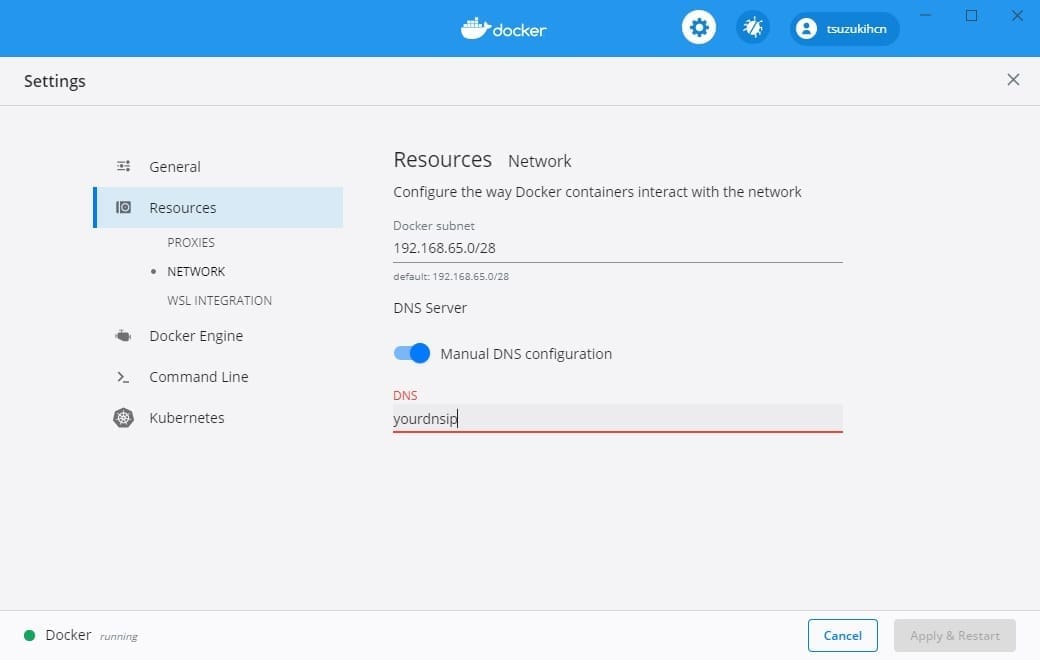
- Docker desktop kubernetes ip how to#
- Docker desktop kubernetes ip install#
- Docker desktop kubernetes ip update#
- Docker desktop kubernetes ip windows 10#
bin/bash -c 'set -a source "$HOME/.systemd-env" set +a exec bash -c ' " $( printf "%q" " " ) " else exec /usr/bin/nsenter -t " $SYSTEMD_PID " -a \ #!/bin/bash SYSTEMD_PID = $(ps -ef | grep '/lib/systemd/systemd -system-unit=basic.target$' | grep -v unshare | awk '' ) " done fi if & then if & & then exec /usr/bin/nsenter -t " $SYSTEMD_PID " -a \ Sudo vi /usr/sbin/start-systemd-namespace # Create the start-systemd-namespace script Let's now switch back to our WSL2 terminal and see if we can (finally) launch the commands: In order to fix it, and finally be able to use the commands, we need to tell the Docker Desktop to "attach" itself to our distro also: If we try, we will have the same error as before. Still, this first setting is still not enough to run the commands inside our distro. What this feature did behind the scenes was to create two new distros in WSL2, containing and running all the needed backend sockets, daemons and also the CLI tools (read: docker and kubectl command). A new window will appear:īy default, the WSL2 integration is not active, so click the "Enable the experimental WSL 2 based engine" and click "Apply & Restart": Now click on the Docker icon and choose settings. You should now see the Docker icon with the other taskbar icons near the clock:

Open the Windows start menu and type "docker", click on the name to start the application: Docker Desktop settings: enable WSL2 integrationįirst let's start Docker Desktop for Windows if it's not still the case. You got an error? Perfect! It's actually good news, so let's now move on to the settings. # Try to see if the docker cli and daemon are installed
Docker desktop kubernetes ip update#
Like for any normal Linux distro, you need to create a user and set a password:Īs we are working, normally, on our local computer, it might be nice to update the sudoers and set the group %sudo to be password-less: Once found, click on the name and it will launch the default Windows console with the Ubuntu bash shell running. Once everything is installed, we can launch the WSL2 terminal from the Start menu, and type "Ubuntu" for searching the applications and documents: For Docker Desktop for Windows, no need to configure anything yet as we will explain it in the next section. Open the Windows store and type "Terminal" in the search, it will be (normally) the first optionĪnd that's actually it.Microsoft Terminal installed from the Windows Store.Docker Desktop for Windows, stable channel - the version used is 2.2.0.4.WSL2 distro installed from the Windows Store - the distro used is Ubuntu-18.04.
Docker desktop kubernetes ip install#
Docker desktop kubernetes ip how to#
Since we will explain how to install KinD, we won't go into too much detail around the installation of KinD's dependencies. When Microsoft revealed WSL - the Windows Subsystem for Linux, the line between Windows and Linux environments became even less visible.Īlso, WSL brought an ability to run Kubernetes on Windows almost seamlessly!īelow, we will cover in brief how to install and use various solutions to run Kubernetes locally.

However, a good number of users (and not only application developers) use Windows OS as their daily driver. Kubernetes has been originally designed to be deployed and used in the Linux environments. While a wide variety of distributions and installers exist to deploy Kubernetes in the cloud environments (public, private or hybrid), or within the bare metal environments, there is still a need to deploy and run Kubernetes locally, for example, on the developer's workstation. Why Kubernetes on Windows?įor the last few years, Kubernetes became a de-facto standard platform for running containerized services and applications in distributed environments.

Docker desktop kubernetes ip windows 10#
New to Windows 10 and WSL2, or new to Docker and Kubernetes? Welcome to this blog post where we will install from scratch Kubernetes in Docker KinD and Minikube.

Authors: Nuno do Carmo Docker Captain and WSL Corsair Ihor Dvoretskyi, Developer Advocate, Cloud Native Computing Foundation Introduction


 0 kommentar(er)
0 kommentar(er)
